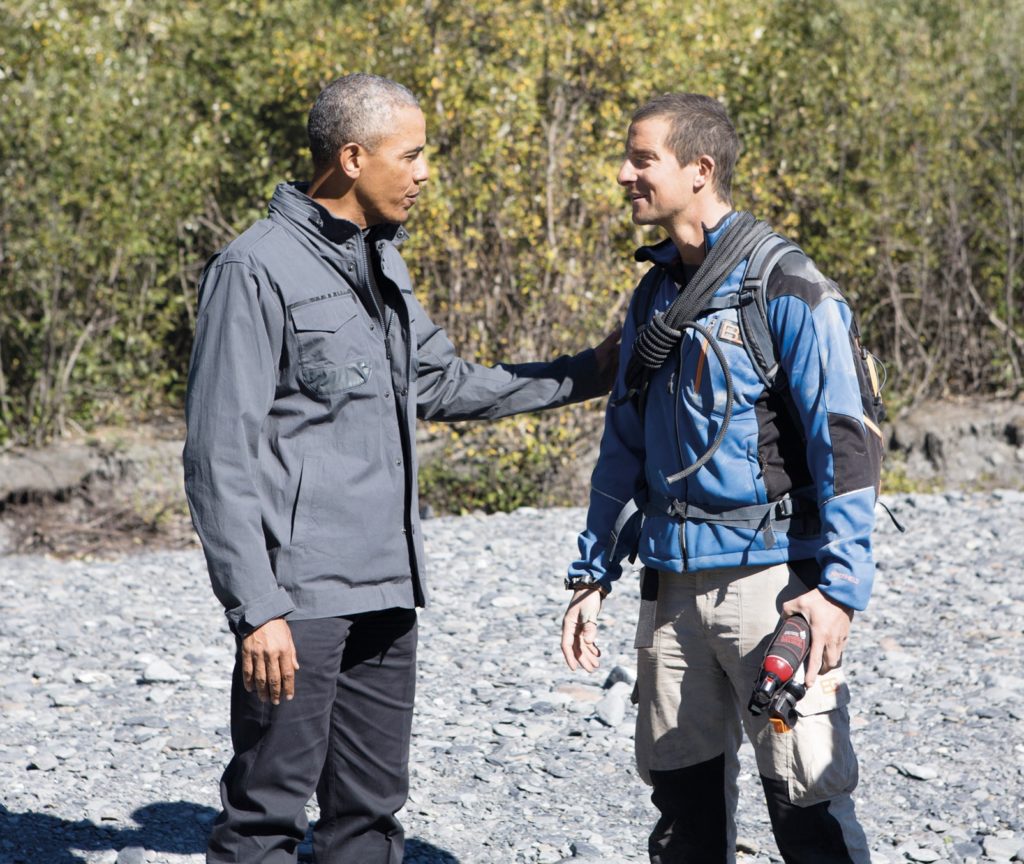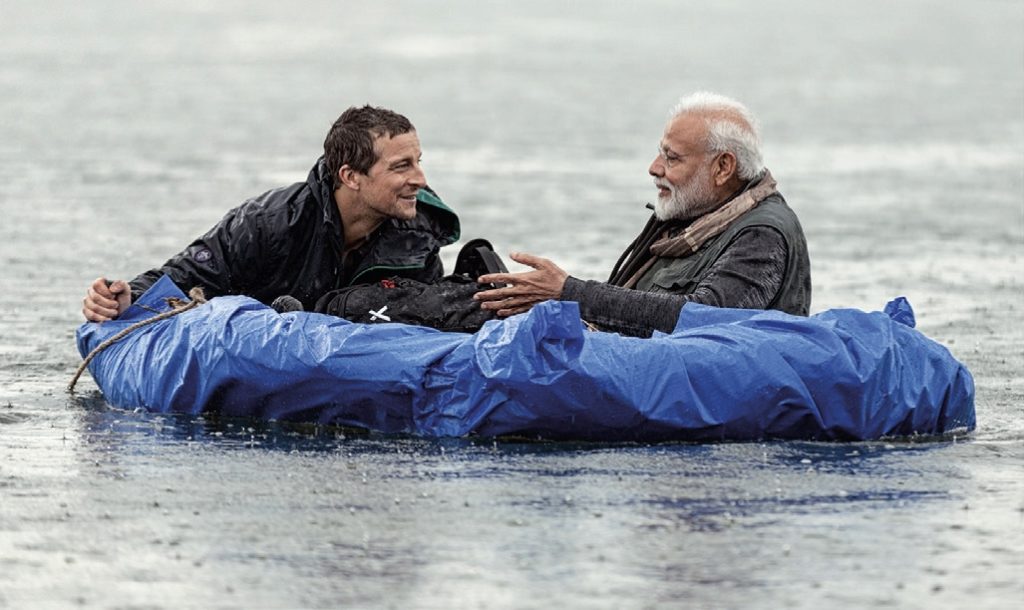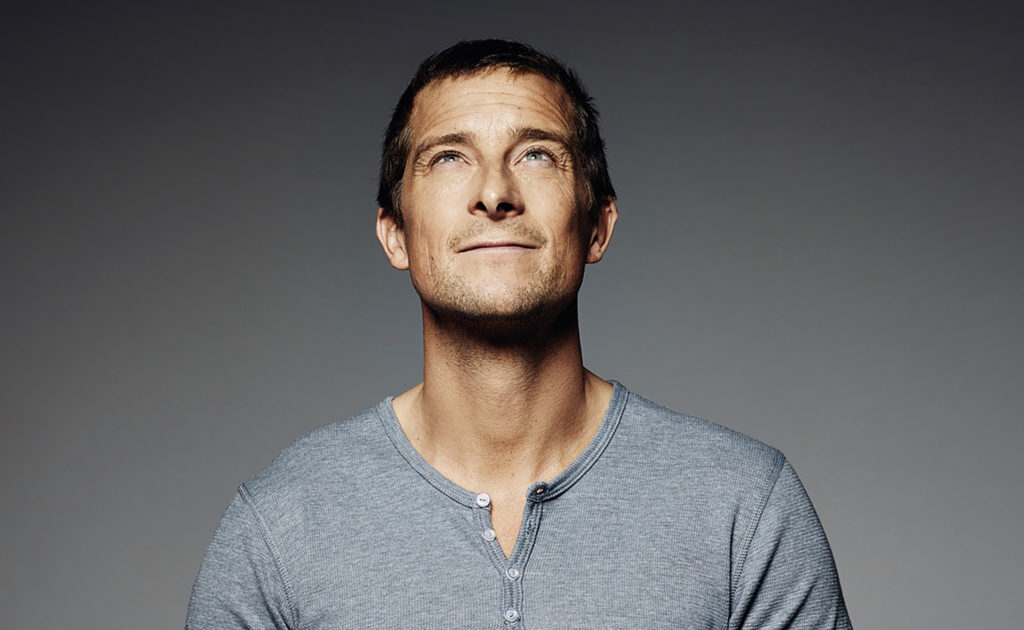When Edward Grylls was a week old, his older sister nicknamed him Bear. She turned out to have a prophetic eye. In the years that followed, her little brother developed into an SAS soldier, survival expert and the world's toughest TV presenter; a career of pushing boundaries, only to break them down with the intransigence of a bear...
In his latest book, the autobiographical Never give up, Bear Grylls recalls memories of expeditions and explores life lessons learned during his adventures.
"If I had to name the grimmest place we have ever worked, the first place that comes to mind is the black swamps in Sumatra. But to be honest: there are plenty of other places that qualify for that title.
Australia's Northern Territory, for instance, is definitely tough terrain, where mosquitoes can make even the most hardened adventurer horny. I remember well when we had to film there and had to plough through the muck and thorn bushes all day to reach the desired location. It would soon get dark and so it was time to set up camp.
Idiotically high temperatures
We were all up after 12 hours of strenuous physical activity in 100 per cent humidity and crazy high temperatures. The mosquitoes became increasingly active during the day, but our local support team and Aboriginal guides were not complaining and so we clamped our jaws together. But by sunset, they and most of the team left towards a dirt road, where cars would take them to our production base, an hour's drive away. Dave and I were left -again- alone, along with a lot of equipment.

We set up camp, undressed and jumped into a muddy creek, not so much to get clean as to cool off a bit. And then, suddenly, it seemed like every mosquito buzzing around our heads had invited as many as a hundred cousins. One minute we were chatting and getting our gear in order, the next the buzzing of those stinging beasts had increased to the point where we had to raise our voices to make ourselves understood. We could literally barely see anything through the thick clouds of insects. A night to remember.
Power of mass
Should you sometimes feel you can't get anything done on your own, come to the Northern Territory around sunset. Then you will see the power of the masses. Those bloody beasts can reduce the strongest men and women to a wailing heap of misery, and quickly too. With mosquitoes, never, ever underestimate their ability to thoroughly disrupt your day.
By morning, we looked like we had been rolling around in a tub of drawing pins. We were a swollen, bleeding, itchy mess, and even then we had slept in a tent.
It made me realise something new again: that, as a survival expert, I have always been more of a visitor than someone who has 'conquered' the wilderness. Take away all the technology and equipment and you soon find yourself back in the same boat our ancestors of millennia past were in. Yes, we can throw some dung on the fire to use smoke to keep the stinging critters at bay, and yes, we can rub mud on our skin to keep them off our bodies, but when it comes down to it, we are never the strongest or toughest in nature. That honour goes to the animals. Hardened, adapted and equipped to survive. Animals are in a constant battle to stay alive, and as a result they are very good at it.
And me? I am just a novice.
I will never forget that journey through the mosquito-infested Northern Territory for several reasons. Not least because it was there that I drank my own urine for the first time. An infamous moment in my life, but a moment nonetheless. Another reason that episode will stay with me is that it was then that I put a snake's head in my mouth for the first time.
In general, people don't like snakes much (something that goes back, I suspect, to the story of Eve, who was tricked by the devil in paradise, after which humans and snakes have never been the best of buddies). Snakes are still responsible for a large number of deaths in the areas I frequent. Our old producer, Steve Ranking, was bitten by a grooved head viper in the jungle of Costa Rica and almost lost his foot (and his life), although we were in hospital within an hour and he was administered antivenom. Some snakes are life-threatening. For example, the bite of the krait in India and the taipan in Australia contain enough venom to fell fifty men. (Piers Morgan once took me aside and said: 'So they only bite men?')
Fangs at the ready
The vast majority of snake bites are the result of self-defence by the snake, and snakes are certainly not the wretched beasts many people take them for. Although, I was once chased by a super-poisonous water moccasin snake in the swamps of Louisiana. The beast came straight at me, shooting through the water in that distinctive s-shape, mouth wide open, fangs at the ready, and clearly intent on giving me a bad day. I was just doing my thing when I saw that monster coming towards me, and I can only recount the story because I managed to grab a stick and smack the beast.
Of course you have aggressive exceptions to the rule, but by no means all snakes are so bloodthirsty. I regularly hang out with snake enthusiasts and that's fine with me; it's just not for me. You won't find rooms stuffed with terrariums at my house.

Anyway, the Northern Territory, then. I was trying to go down a small creek, far away from everything and everyone. The water reached up to my chest when suddenly I saw a one-and-a-half-metre snake swimming by.
I grabbed him by the tail and pulled him towards me.
There are several ways to kill a snake. The quickest way, which I had heard of but had never seen with my own eyes, is to grab the snake by the tail, swing it above your head like a lasso and then whip it to the ground like a whip. Now, grabbing a snake by the tail is not harmless, as snakes tend to turn around at lightning speed and bite you, but if you start swinging fast enough you generate so much centrifugal force that the snake has no chance to strike. This is also an extremely humane way to kill snakes, although it looks a bit clumsy. I did it once in the Chinese rainforest and it worked fine then.
But back to Australia. I was just about to finish the snake and put it away to prepare it later when one of our Aboriginal guides gave me a suggestion. He explained that some Aboriginal women used to kill snakes by grabbing them by the head (which is better than by the tail, as long as you pin the snake first) and then (and this was the deciding factor) putting the whole head, alive and well, into their mouths to break the neck with their teeth.
We looked at each other and thought exactly the same thing: you don't mean this.
But of course there was some goofy guy on the team who said, 'Actually, that would be cool to show...' And before I knew it, I was standing on the bank, in the middle of nowhere, holding a wildly moving snake in my hand while the rest of the crew was discussing whether this technique would work or not.
Our guide added that he had never seen it himself, but lore said it was done and he was reasonably sure it would work. Knowledge that was of little use to me at the time. I could already picture the snake biting me in my throat, after which it would end badly.
Still, I decided it was worth it. If it worked, it was basically a very quick, humane way to kill the snake. I tried not to think too much and gripped the head a bit more firmly.
I brought the animal to my face. Even that felt wrong. I opened my mouth wide and pushed the head of the snake inside.
As soon as I was sure the head was completely in my mouth, I bit. I felt the head, then I bit even harder and started shaking my head to make sure it couldn't move. This was the moment I was most afraid of, because I knew my bite would force the snake to open its own mouth, and if I acted half-heartedly it might bite me if I pulled it out of my mouth again. So I did the latter super fast, after which I dangled it. His neck appeared broken and blood was dripping from his head. He jerked and squirmed like snakes do when they have just been killed. My heart pounded in my throat. Adrenaline coursed through my body and I looked at Simon and Dan, our two cameramen.
No one said anything.
I took a deep breath and walked out of the picture saying, "Well, the food is also taken care of.
That had become a bit my standard phrase for when I had pulled my meal together, an expression born out of habit. Whether I had outsmarted a lizard, iguana, snake or scorpion, all too often it meant one thing: food.
When I turned around again, I heard Simon say those awful words: 'Sorry, Bear, but I didn't press record.'
I couldn't believe it. After all that?
'You're joking, right?'
He shook his head. 'We didn't... Sorry.'
It was only after two days that he said it was indeed a joke.
It was all on film. And it was gold."
ABOUT BEAR GRYLLS
Bear Grylls is one of the world's best-known faces in the world of survival and outdoors.
He trained in martial arts as a child and later served three years in the British Army, in the Special Forces. There, he perfected many survival skills. After a parachute accident in Africa, in which he broke his back in three places, Grylls managed to make a full recovery. Soon after, he became one of the youngest climbers to summit Mount Everest.
He presented seven seasons of the Emmy-nominated hit series Ultimate Survival, a programme that became one of the best-watched TV series in the world, with an estimated 1.2 billion viewers. Since then, he has made more TV programmes about extreme survival than anyone else, including six seasons of the global hit Running Wild with Bear Grylls. In it, he took some of the world's biggest stars on adventures, including President Obama, Julia Roberts, Roger Federer, Will Ferrell, Channing Tatum, Kate Winslet and Prime Minister Modi of India.
Grylls' autobiography Mud, Sweat and Tears ranked No 1 in the Sunday Times bestseller list for 15 weeks. Grylls is Honorary Colonel of the Royal Marines Commandos, the youngest ever Chief Scout in the UK and the world's first ever Chief Ambassador of the World Scout Organisation, in which capacity he represents a global family of some 50 million scouts.
He is married to Shara and together they have three sons: Jesse, Marmaduke and Huckleberry. They live on a houseboat on the Thames in London and on a private island off the coast of Wales. Grylls' life motto is simple: Treat others well, be brave and... never give up!
 The above story is from:
The above story is from:
Bear Grylls - Never give up
Luitingh Sijthoff | ISBN: 9789024597161 | Pages: 336 | € 21
Photos in the book are from: Ben Simms, Ben Kenobi, Emma Myrtle, ngc Networks, us llc, Bear Grylls Ventures, llp and Electus llc., Potato tv and itv Studios, Andrew Matthews, wpa Pool/ Getty Images, Sara Donaldson , Hamish Brown.



